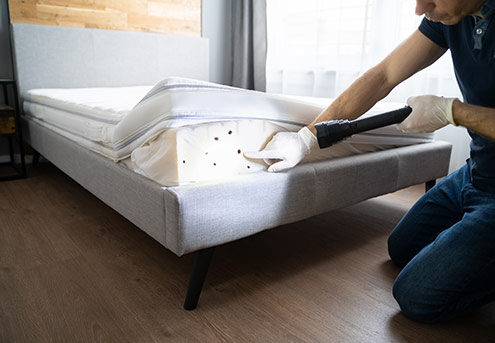Bed bugs are the type of pests nightmares are made of. The thought of a tiny creepy insect crawling over your body at night is enough to make your skin curl. Unfortunately, contrary to popular stereotypes, these harrowing creatures are not just akin to dirty apartments or late-night sleazy hotels. Any residence or business in California can find itself wracked with bed bugs. When that happens, it can make life miserable for you, your family, and your pets.
But don’t worry. We’re here at AAI Pest Control to tell you everything you need to know about bed bugs, how to identify them, prevent them, and if by some unfortunate circumstance you obtain them, how to help you get rid of them.
How to Identify Bed Bugs
These tiny pests are hard to identify because they are so small. They are about ¼ to ⅜ in length, oval-shaped, flat, brown, and wingless. If you aren’t looking for them, you may think they are just specks of fuzz on your bed sheets.
How Do Bed Bugs Get Into Your Home?
Bed bugs are excellent hitchhikers latching onto anything they can cling onto. They can enter your home through your clothes, luggage, purses, backpacks, furniture, and bedding.
They can travel between rooms in multi-unit buildings, such as apartment complexes and hotels. Once inside, they usually hide behind headboards, in between cushions on sofas, behind curtains, wall hangings, under mattresses, and in between box springs.
These little critters move very fast over smooth surfaces scattering from one place to the next.
If possible, they prefer to make their home on our beds because this is where they have easy access to your blood meal. Hence, where they got the name, bed bugs. Some of the most common places these pests come from include:
- Hotels or motels
- Work or school
- Neighbors in condos, apartment complexes, or any attached housing
- Used clothing
- Used furniture
- Used appliances, books, or accessories
Are Bed Bugs Dangerous?
While bed bugs don’t transmit or carry diseases, they do cause itchy, red bites. And like mosquitoes, one single bed bug can bite its host several times. If an infestation of bed bugs is present, tons of bites in one night may occur. When one of these blood-suckers attacks, it injects an anesthetic and an anticoagulant (to inhibit bleeding), which prevents most people from realizing they’ve been bitten. This means that red swollen marks may not appear until one or two days later, making it even harder to spot an infestation.
On rare occasions, serious allergic reactions may occur. For most people, a simple antihistamine will help.
Still, having bed bugs is a huge nuisance. One female can lay between 200 and 500 eggs at a time. Not only do these annoying pests bite, they also have stink glands that leave off a musty, sweet smell like that of wet towels. They also leave disgusting fecal spots on your bed sheets and around hiding places.
How Can You Tell if You Need Bed Bug Control?
Often the first indication you have bed bugs is from the foul odor coming from your bedroom. As mentioned above, bed bugs leave off alarm pheromones in response to being threatened. This scent often smells like wet laundry, mold, or rust. Other signs of an infestation include:
- Dark droppings of fecal matter. This is often dark red and round shaped.
- Dried blood on your bedding or furniture.
- Eggs loosely stuck to various surfaces and about 1mm in length.
- Yellowish-brown shell casings. These are from the young, immature bed bugs after they molted into adults.
- Small, red, itchy bumps appear on your skin.
- And lastly, actual bed bug sightings.
How Can I Help Prevent Bed Bugs?
First, keep in mind that anyone can get or have bed bugs. As more people travel, use lodging, and share housing, bed bugs and other pests find ways to navigate from one shelter to another. The best way to help prevent an infestation is by lowering your chances of them hijacking your home. You can do this by utilizing the following methods:
- Inspect all lodging – Because you can’t control the environment outside your home, it’s best to thoroughly inspect any hotel or lodging you use. When you first arrive, inspect the space. Check the bed, behind the curtains, around the walls, and on the carpet.
- Immediately wash clothes and luggage after traveling to avoid stragglers.
- Store items in plastic containers. – Bed bugs find it hard to maneuver around smooth surfaces and will be unable to get in.
- Vacuum carpet and upholstery regularly.
- Wash sheets on the highest setting the manufacturer instructions allow once a week. The heat will kill bed bugs and their eggs.
- Always remove clutter from the floor.
- Put your mattress and box spring in dust mite-proof casings.
- Avoid storing items under your bed.
- And lastly, avoid bringing home furniture found from curbs or dumpsters.
Call In the Professional Bed Bug Exterminators at AAI Pest Control
Managing a bed bug infestation can be a difficult and time-consuming task. More often than not, it includes washing all bedding, carpeting, stuffed animals, and furniture, and the use of heat or steam treatments several times. Save your time and energy by calling in the professionals. If you find yourself faced with a bed bug infestation, call the bed bug exterminators at AAI Pest Control. We offer a highly effective bed bug treatment to help you eliminate these dreadful creatures. Call 209-545-0789 or contact us online now.
Where Do Bed Bugs Come From and How Do I Prevent Them Professional Pest Control Services in Tracy CA?
Serving Northern California

